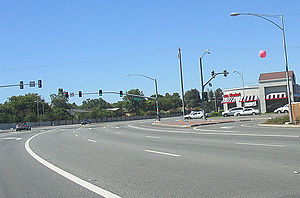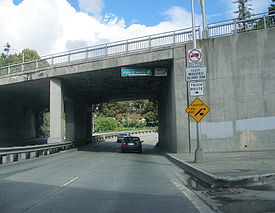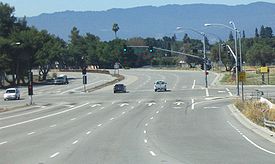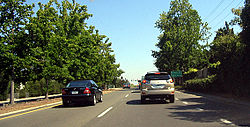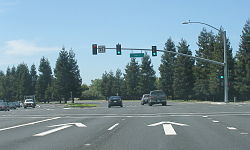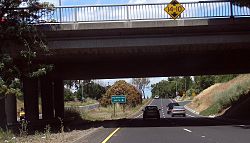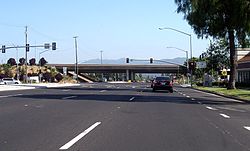- California County Routes in zone G
-
There are 21 routes assigned to the "G" zone of the California Route Marker Program, which designates county routes in California. The "G" zone includes county highways lying in the counties of Monterey, San Benito, San Luis Obispo, Santa Clara, and Santa Cruz.
Contents
G1
County Route G1 Location: San Benito County Length: 5.42 mi[1] (8.72 km) Existed: 1958–present[1] County Route G1 is a road providing access to Fremont Peak State Park.
G2
County Route G2 Location: Santa Clara County Length: 9.7 mi (15.6 km) County Route G2, more commonly known as Lawrence Expressway and Quito Road, is a busy 9.7 mile (16 km) long north–south link through Silicon Valley in Northern California. The majority of G2 is part of the Santa Clara County Expressway System.
Route description
G2 runs from the Quito Road overcrossing of SR 85 in Saratoga, north along Quito Road. G2 is not signed along this section and is not commonly recognized as existing along this 2 lane road by either locals or mapmakers. The Quito Road portion is also maintained by the City of Saratoga rather than Santa Clara County.[2]
As the road leaves Saratoga and enters San Jose, it widens to a 6 lane county-maintained expressway with a concrete island divider; at this point it becomes Lawrence Expressway. The Lawrence Expressway section from just south of Saratoga Avenue is more readily recognized as G2. Local residents almost exclusively refer to G2 as Lawrence Expressway. The road continues north, with access usually restricted to major intersections which are controlled via traffic lights.
Lawrence Expressway continues northeasterly and junctions with I-280 and Stevens Creek Boulevard over a complex shared separated grade crossing. Lawrence proceeds under I-280 before immediately rising over Stevens Creek. Lawrence Expressway and Stevens Creek also share ramps for access to I-280 with the exception of the onramp to Southbound I-280 which is accessed directly from Lawrence Expressway, a frequent cause of confusion for drivers on Stevens Creek wishing to access I-280 due to unclear signage.[citation needed] Lawrence Expressway continues north into Santa Clara and widens to 8 lanes with an HOV lane occupying the far right lane.
Lawrence Expressway also has another separated grade interchange with El Camino Real (SR 82) with Lawrence Expressway passing over El Camino Real just prior to Lawrence Expressway entering Sunnyvale. Lawrence Expressway also passes under Central Expressway (G6) on a separated grade interchange and over US 101 on a separated grade interchange. The US 101 interchange was recently upgraded to include traffic light control on G2.
G2 reaches its northern terminus at the end of Lawrence Expressway at the SR 237 Freeway. The physical road continues north as Caribbean Drive.
History
G2 was first signed as a Santa Clara County Route in 1962. County Route G2 was originally planned to link up with SR 85 when it was built. At the time of G2's inception SR 85 was in the early planning stages and an interchange had been envisioned at Quito Road. However opposition to the freeway was intense in Saratoga and the planned interchange between SR 85 and G2 along with an interchange further north at Prospect Road were abandoned in favor of the existing Saratoga Avenue interchange. G2 is unsigned from SR 85 to Saratoga Avenue along Quito Road. North of Saratoga Avenue Lawrence Expressway is currently signed as G2.
In the 1990s Lawrence Expressway was widened north of I-280 to 8 lanes to accommodate an HOV carpool lane.
The section of Quito Road between Bucknall Road and Saratoga Avenue in Saratoga is slated for expansion to 3 lanes in the fall of 2006.
G3
County Route G3 Location: Santa Clara County Length: 4.52 mi[1] (7.27 km) Existed: 1962–present[1] County Route G3, more commonly known as Page Mill Road and Oregon Expressway is a short 4.5 mile (7 km) northeast-southwest arterial route that spans the lower peninsula region of the San Francisco Bay Area from I-280 to US 101. G3 runs through Palo Alto, California, unincorporated Stanford University lands, and the northwest corner of Los Altos Hills, California and is part of the Santa Clara County Expressway System.
Route description
G3 begins in the west at its interchange with I-280 in Los Altos Hills just south of Stanford University. It proceeds northeast as a four lane expressway over the rolling hills of Stanford University until it reaches Foothill Expressway (G5) with which it shares an at-grade intersection. East of Foothill Expressway, G3 descends down into the more urban areas of the lower peninsula going through the industrialized area of the Stanford Research Park located in Palo Alto. The road along this section has a reduced speed limit and several turnoffs along its length until it reaches El Camino Real (SR 82).
After SR 82, Oregon Expressway branches from Page Mill Road, which becomes a short two-lane street, and G3 follows Oregon Expressway under Caltrain tracks and onward for the remainder of its northeastward journey. Oregon Expressway resumes expressway status with limited access confined mainly to large intersections. G3 reaches its eastern terminus at its junction with US 101.
Page Mill Road (no longer designated G3) continues southwest of I-280 for 6 miles (9.7 km), a twisting two-lane road that climbs to Skyline Boulevard (SR 35) at the crest of the Santa Cruz Mountains. It passes the entrance to Palo Alto's Foothills Park (which is accessible to Palo Alto residents and their guests only) and the Monte Bello and Los Trancos Open Space Preserves. Under the name West Alpine Road, the road descends west of Skyline Boulevard to a turn-off that leads to Portola Redwoods State Park, where the original Page (saw)mill is located. No artifacts remain at the mill site, which is accessible only by trail, either from Portola Redwoods state park or from Skyline Boulevard (SR 35).
History
This route was designated in 1962. G3 is currently signed its entire length. It was originally known as Mayfield-Pescadero Road.[3]
G4
County Route G4 Location: Santa Clara County Length: 14.11 mi[1] (22.71 km) Existed: 1962–present[1] County Route G4, more commonly referred to as San Tomas Expressway and Montague Expressway is a busy 14.5 mile (23 km) long link across Silicon Valley. G4 is part of the Santa Clara County Expressway System.
Route description
G4 begins in the south at its interchange with SR 17 and Camden Avenue as San Tomas Expressway in the city of Campbell. The road is three lanes wide in each direction, with an HOV carpool lane occupying the right lane, from SR 17 north to El Camino Real (SR 82), where it expands to four lanes in each direction with an HOV lane until San Tomas "ends" at US 101. The majority of intersections along San Tomas are at grade controlled by traffic lights. The only separated grade intersections along San Tomas are at SR 17, US 101, Winchester, and the junction with Central Expressway (G6). G4 intersects at grade with El Camino Real in Santa Clara. Further north in Santa Clara, G4 crosses US 101 and becomes Montague Expressway.
Montague Expressway is signed as an east–west route, however it is not signed as G4 along its entire length. Montague continues east as an 8 lane road until it crosses Interstate 880 on the San Jose/Milpitas city line, where it loses a lane to become a 6 lane road. G4 reaches its eastern terminus at Interstate 680 but the physical road continues as Landess Ave. further east until it ends at its intersection with Piedmont Road.
History
G4 was designated and signed in 1962 along the San Tomas portions. Montague was designated later around 1978. Whether this has anything to do with Montague not being physically signed as G4 is uncertain. Emergency Call boxes along Montague however are labeled as being on G4 leaving no doubt that Montague is part of G4.
Original plans called for G4 to originate at present day G21's junction with US 101, then head north via present day Capitol Expressway, Hillsdale Avenue, and Camden Avenue where it would have met the present day southern terminus. These plans were never brought to fruition.
From SR 82 south to Interstate 280, G4 is an unsigned part of the Juan Bautista De Anza National Historic Trail which follows the route Juan Bautista de Anza took leading his expedition into California from Mexico in 1775-76 (note: to continue north on the trail you must utilize Saratoga Avenue to access I-280 as G4 has no interchange with the interstate).
G5
County Route G5 Location: Santa Clara County Length: 7.24 mi[1] (11.65 km) Existed: 1962–present[1] County Route G5, more often referred to as Foothill Expressway, is a 4 lane, 7.24 mile (11.6 km) long, northwest-southeast route in Santa Clara County. G5 connects Palo Alto, California to the Silicon Valley proper closely paralleling I-280 through the lower Santa Cruz Mountains foothills. This route is part of the Santa Clara County Expressway System.
Route description
G5 begins at its southeastern end at I-280 in Cupertino, California. It proceeds northwest directly east of I-280 making it a viable alternative route for short trips between Cupertino and Palo Alto. The road is a four-lane expressway along its entire route. Access is generally limited to major intersections that are governed by traffic lights. G5 travels through several affluent neighborhoods in Los Altos before climbing up into the foothills to its northern terminus at the intersection with Page Mill Road (G3). The physical road continues north as Junipero Serra Boulevard and passes the back entrances to Stanford University.
History
G5 was designated in 1962 and is currently signed its entire length. The route was built upon the right-of-way for the Los Altos branch of the Peninsular Railway. The buildings along the route at Loyola Corners in Los Altos are historical railroad station buildings.
In 1970 one of the first scientifically-designed noise barriers in the nation was conceived for Foothill Expressway in a study overseen by the Santa Clara County Public Works Department using Sunnyvale consultant ESL Inc.
G6
County Route G6 Location: Santa Clara County Length: 12.33 mi[1] (19.84 km) Existed: 1962–present[1] County Route G6, which comprises Central Expressway and part of Alma Street in Palo Alto is signed as a 12.3-mile (19.8 km) long, east–west route in the western portion of Silicon Valley, California. This designation is a bit odd as Central Expressway parallels US 101, El Camino Real (SR 82) and I-280, all of which are signed north–south. This route is part of the Santa Clara County Expressway System.
Route description
Route G6 actually begins in the west at Oregon Expressway as Alma Street in Palo Alto. In Palo Alto, G6 remains a major surface street with four lanes of traffic and a center turning lane to service the many driveways and turnoffs available. At the Palo Alto – Mountain View border at San Antonio Road, G6's character changes, removing the driveways and frequent intersections and adding a center divider, and is renamed Central Expressway. Central continues east as a 4 lane road through the city of Mountain View. Through this section Central Expressway has more at-grade intersections than is typical for a designated expressway. This section's intersections are primarily at-grade with cross streets controlled by traffic lights, although there are some overpasses, such as for San Antonio Road, Shoreline Blvd., Whisman Ave, SR 237 and SR 85.
Up to this point, the road parallels the Caltrain rail line, which limits the intersections and driveways on the south side of the road.
After crossing under SR 85, Central Expressway takes on a very freeway-like appearance (which is not typical for most county roads) for several miles through Sunnyvale. Through this section Central Expressway has a wide center divider and a sequence of several separated grade interchanges with main cross streets and no turnoffs or driveways. The final in this sequence is at Lawrence Expressway. East of Lawrence Expressway, Central Expressway resumes at grade intersections along with sporadic HOV lanes at the approaches to intersections. Central has one final separated grade interchange with San Tomas Expressway. Central reaches its end at De La Cruz Blvd in Santa Clara, just outside the north end of San Jose International Airport. Route G6 makes a turn on to De La Cruz for a few hundred feet until it reaches US 101, which serves as the route's eastern terminus.
History
Central Expressway was first designated in 1962. Central Expressway was a vital route through the western Silicon Valley in the days before US 101 and I-280 had been widened as an alternate route. Central Expressway still acts as an alternate route to US 101 through the west valley, however usage has declined as both freeways are now much larger and more direct routes. Construction was completed in 2007 near the eastern terminus widening Central Expressway to accommodate an HOV lane and a reconfiguration of the intersection with Lafayette Street.
Central Expressway is currently signed as G6 sporadically along its entire length.
In 1982, the prohibition against bicyclists using Central Expressway's shoulders was lifted. All pedestrian prohibitions were repealed by 2003.
G7
County Route G7 Location: Santa Clara County Length: 3.25 mi[1] (5.23 km) Existed: 1962–present[1] County Route G7 is a road in Santa Clara County southeast of Gilroy. The road is known as Bloomfield Avenue for its entire length, which runs from State Route 25 near US 101 to State Route 152.
G8
County Route G8 Location: Santa Clara County Length: 29.38 mi[1] (47.28 km) Existed: 1962–present[1] County Route G8 is an important north–south arterial from the south valley area of Santa Clara County, California, USA to near Downtown San Jose. G8 runs for 29.4 miles (47 km) over both rural roads, expressway and urban streets, but it is most commonly known by residents for its expressway portion, Almaden Expressway. G8 is also part of the Santa Clara County Expressway System.
Route description
G8 begins in the south at the its junction with State Route 152 in Gilroy. It proceeds north along Watsonville Road as a two-lane country road until it reaches the intersection of Watsonville Rd and Uvas Road. G8 turns left and proceeds north along Uvas Road which is a winding two-lane mountain road that passes by Uvas, Chesbro and Calero reservoirs and their surrounding parks. In Calero Reservoir County Park, Uvas Road is renamed McKean Road and proceeds into the Almaden Valley area of San Jose. At the north end of McKean Rd, G8 turns briefly right on Harry Road for a short distance and then left on to the south end of Almaden Expressway.
As Almaden Expressway G8 expands to a 4-8 lane divided expressway with a large center divider and the majority of access limited to major intersections controlled by traffic signals. The major exception to this is near Highway 85 and Blossom Hill Road (G10) where there are several major shopping centers.
G8 intersects G10 at Blossom Hill Rd and SR 85 a quarter mile north. This interchange is one of the busiest in Silicon Valley due to several shopping centers and a Costco warehouse store all sharing driveways with this interchange. G8 continues north resuming its expressway design. G8 shares a separated grade interchange with the terminus of Capitol Expressway Auto Mall and again with Curtner Avenue. Other intersections along this part of the route are at grade. Almaden Expressway crosses State Route 87 with which it shares a northbound only interchange.
G8 continues past the north end of Almaden Expressway on to Almaden Road which is a 4 lane city street. At the intersection Almaden Rd and Alma Avenue, G8 turns east along Alma Ave and proceeds for about a quarter mile to its eastern terminus at First Street (SR 82).
History
G8 was originally designated in 1962 along Almaden Expwy which had begun construction in 1959. Almaden Expwy was not completed to its southern terminus until 1984. Before that time the section between McKean Rd and the southern end of the expressway (which was further north at the time) took a zig zag path from McKean Rd to Harry Rd to Almaden Road (S) to Barnes Lane, to the then southern end of Almaden Expwy.
G8 is signed sporadically along its entire length.
G9
County Route G9 Location: Santa Clara County Length: 4.17 mi[1] (6.71 km) Existed: 1963–present[1] County Route G9 is a county road in Gilroy and unincorporated Santa Clara County. The route runs along Leavesley Road from State Route 152's northern interchange with US 101 and then curves southward onto Ferguson Road. The route's southern terminus is at Route 152 (Pacheco Pass Highway) east of Gilroy.
G10
County Route G10 Location: Santa Clara County Length: 10.34 mi[1] (16.64 km) Existed: 1964–present[1] County Route G10, more commonly known along the majority of its route as Blossom Hill Road for the majority of its length is an important east–west arterial roadway through the Almaden Valley area of Santa Clara County, California, in Silicon Valley. The route runs for 10.34 miles (16.64 km) and is a city street for its entire length.
Route description
G10 begins at its western end at the junction of SR 17 and Los Gatos-Saratoga Road (formerly Saratoga Avenue) in Los Gatos. G10 travels east on Los Gatos-Saratoga Road to the end of that road then turns north east along Los Gatos Boulevard. G10 proceeds for 3/4 of a mile (1.2 km) to Blossom Hill Road where it turns east. Along this stretch, G10 is a narrow road that proceeds over Blossom Hill, the hill that the road takes its name from. At the base of Blossom Hill, G10 enters San Jose and the Almaden Valley neighborhood.
G10 proceeds as a busy 4-6 lane artery through this area, intersecting Almaden Expressway and further east, through the Blossom Valley neighborhood of San Jose, to SR 85. Prior to the completion of SR 85 in 1994, which G10 roughly parallels, Blossom Hill Road was the major accessway to this area of San Jose from the west.
G10 reaches its eastern terminus at SR 82, a few hundred feet (~100 m) shy of US 101. Blossom Hill Road continues to US 101 and then over the freeway becoming Silver Creek Valley Road.
History
G10 was designated in 1964 as a county road. As of 2005, however, the road is no longer maintained by the county and is city street along its entire length. G10 is also only sporadically signed along its route and has been largely abandoned by the county after the completion of SR 85.
G11
County Route G11 Location: Monterey County Length: 8.96 mi[1] (14.42 km) Existed: 1965–present[1] County Route G11 is a road in unincorporated Monterey County. The route runs from Watsonville and Pajaro along San Juan Road through the Pajaro Valley and terminates at US 101 south of Aromas.
G12
County Route G12 Location: Monterey – Santa Cruz Counties Length: 10.54 mi[1] (16.96 km) Existed: 1965–present County Route G12 is a road in Santa Cruz and Monterey Counties. The route, running almost 11 miles (18 km), begins at US 101 near Prunedale and follows San Miguel Canyon Road 4 miles (6 km) north-northwestward to Hall Road, onto which the route turns westward for 3 miles (5 km) passing through the community of Las Lomas. This portion arrives at Elkhorn Road, where G12 turns northward for 1 mile (2 km) before joining Salinas Road first to enter Pajaro, where the route becomes Porter Road, and then to enter Watsonville, where the route joins Main Street and terminates at State Route 129.
G13
County Route G13 Location: Monterey – San Benito Counties County Route G13 is a county road in Monterey and San Benito Counties. The route runs almost 16 miles (26 km) between King City in Monterey County and Route 25 in San Benito County.
G14
County Route G14 Location: Monterey – San Luis Obispo Counties County Route G14, running approximately 62 miles (100 km), connects the Mission San Antonio area northwest of Jolon, California, in the southern part of the county to Lake Nacimiento and then continues into northern San Luis Obispo County connecting to West 24th Street in Paso Robles where it meets U.S. Route 101 and SR 46 near the California Mid-State Fair fairgrounds.
County Route G14 is a California State Scenic Highway.
G15
County Route G15 Location: Monterey County Monterey County Route G15 is a road running almost 19 miles (31 km) along the eastern edge of the Salinas Valley. The road parallels US 101 (and therefore El Camino Real) between King City and Soledad, with 101 to the west of the Salinas River and G15 to the east and following the western foot of the Gabilan Range.
The route begins at US 101 southeast of King City and follows First Street through the city, where it intersects County Route G13 and exits the city as Metz Road. G15 follows this road 17 miles (27 km) northwestward, bypassing Greenfield and terminating at State Route 146 near Soledad.
G16
County Route G16 Location: Monterey County Monterey County Route G16 runs 56 miles (90 km) between the Santa Lucia Range and the Sierra de Salinas in Monterey County, California. The route, beginning in Carmel, follows Carmel Valley Road along the Carmel River into the Carmel Valley and southeastward into the community of the same name, near which the road intersects with Monterey County Route G20. After 41 miles (66 km) the route turns eastward onto Arroyo Seco Road. Upon entering the Salinas Valley, G16 joins Elm Avenue, later passing through Greenfield, crossing the Salinas River, and terminating at Monterey County Route G15 near the valley's eastern edge.
G17
County Route G17 Location: Monterey County G18
County Route G18 Location: Monterey County This route is signed as Jolon Road and runs between U.S. Route 101 on both ends.
G19
County Route G19 Location: Monterey – San Luis Obispo Counties G20
County Route G20 Location: Monterey County County Route G20, also known as Laureles Grade, is a steep, winding road running 6 miles (10 km) to connect Carmel Valley with State Route 68 halfway between Monterey and Salinas.
G21
County Route G21 Location: Santa Clara County Santa Clara County Route G21, more commonly known as Capitol Expressway for the majority of its length is a 9.5 mile (15 km) long east–west expressway completely in San Jose, California, USA along the eastern side of the Silicon Valley. Capitol Expressway is part of the Santa Clara County Expressway System.
Route description
G21 begins as Capitol Expressway Auto Mall in the west at its separated grade junction with Almaden Expressway as a continuation of Hillsdale Avenue. It travels east along Capitol Expressway Auto Mall as an unsigned city maintained street until the road reaches State Route 87. Along this section Capitol Expressway is lined with many car dealerships with multiple driveways and turnoffs in addition to at grade crossings with smaller roads. At the interchange with SR 87 the road becomes Capitol Expressway and takes on a more traditional expressway appearance with limited turnoffs and most entrances being solely at large intersections.
Capitol Expressway continues south east to a junction with Highway 101 and then into East San Jose. In East San Jose Capitol Expressway intersects with I-680 and officially ends at Jackson Avenue, changing names into E. San Antonio Street.
A common misconception is that Capitol Expressway makes an abrupt turn to the northeast toward Alum Rock. This road is actually called Capitol Avenue and continues on towards Milpitas and serves as a major corridor through the North Valley. Capitol Avenue reaches its northern terminus in Milpitas at the intersection of Montague Expressway.
History
Capitol Expressway was designated in 1978 from Almaden Expressway to US 101. Construction on the eastern portion from US 101 to I-680 was not completed until 1997.
In the late 1990s the portion of the Expressway from Almaden Expressway to SR 87 was transferred from Santa Clara County to the city of San Jose. The road was then renamed Capitol Expressway Auto Mall.
Capitol Expressway is currently unsigned from Almaden Expressway to SR 87 however it is signed east of SR 87.
References
- ^ a b c d e f g h i j k l m n o p q r s t u Faigin, Daniel. "County Routes 'G'". California Highways. http://cahighways.org/countyg.html. Retrieved 2010-01-29.
- ^ City of Saratoga Dept of Public Works
- ^ Florence M. Fava (1976). Los Altos Hills, The colorful story. Woodside, CA: Gilbert Richards Publications.
 Categories:
Categories:- California County Routes
Wikimedia Foundation. 2010.

